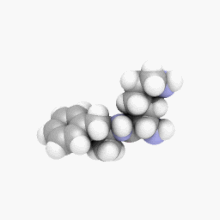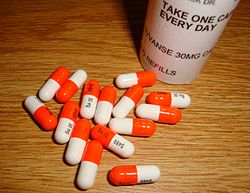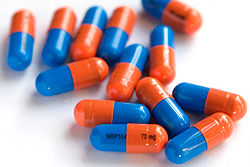User:Fuse809/sandbox5
 | |
 | |
| Clinical data | |
|---|---|
| Trade names | Tyvense, Elvanse, Venvanse, Vyvanse |
| Other names | (2S)-2,6-diamino-N-[(1S)-1-methyl-2-phenylethyl]hexanamide (2S)-2,6-Bis(azanyl)-N-[(2S)-1-phenylpropan-2-yl]hexanamide |
| AHFS/Drugs.com | Monograph |
| MedlinePlus | a607047 |
| License data |
|
| Pregnancy category |
|
| Routes of administration | Oral |
| ATC code | |
| Legal status | |
| Legal status |
|
| Pharmacokinetic data | |
| Bioavailability | 28% |
| Metabolism | Gastro-intestinal (initial); Hepatic (extensively CYP2D6) after conversion to d-amphetamine |
| Elimination half-life | < 1 hour (prodrug molecule), 10-13 hours (d-amphetamine) |
| Excretion | Urine (96%), faeces (minimal) |
| Identifiers | |
| |
| CAS Number | |
| PubChem CID | |
| DrugBank | |
| ChemSpider | |
| UNII | |
| ChEMBL | |
| Chemical and physical data | |
| Formula | C15H25N3O |
| Molar mass | 263.378 g/mol g·mol−1 |
| 3D model (JSmol) | |
| |
| |
| | |



Lisdexamfetamine dimesylate (L-lysine-D-amphetamine; sold as Tyvense (IE), Elvanse (UK), Venvanse (BR),Vyvanse (AU, CA, US)) is a psychostimulant prodrug of the phenethylamine and amphetamine chemical classes. Its molecular structure consists of dextroamphetamine coupled with the essential amino acid L-lysine.
Lisdexamfetamine itself is inactive and acts as a prodrug to dextroamphetamine upon cleavage of the lysine portion of the molecule. It was developed for the intention of creating a longer-lasting and less-easily-abused version of dextroamphetamine, as the requirement of conversion into dextroamphetamine via enzymes in the red blood cells increases its duration, regardless of the route of ingestion.[1] The drug lisdexamfetamine dimesylate is the first prodrug of its kind. Studies conducted show that lisdexamfetamine dimesylate may have less abuse potential than d-amphetamine and an abuse profile similar to diethylpropion at dosages that are FDA-approved for treatment of ADHD, but still has a high abuse potential when this dosage is exceeded by over 100%.[2] There is no increased onset or effect as occurs with IV administration of dextroamphetamine compared to oral use of the same. Intravenously administered lisdexamfetamine produced likability effects similar to placebo, therefore affirming the drug's ability to reduce abuse potential.[3]
Lisdexamfetamine is indicated for the treatment of attention deficit hyperactivity disorder (ADHD) in children six to twelve years and in adults as an integral part of a total treatment program that may include other measures (i.e., psychological, educational, social). The safety and the efficacy of lisdexamfetamine dimesylate in patients three to five years old have not been established.[4] Important side effects of therapeutic lisdexamfetamine include stunted growth in young people and, occasionally, a psychosis can occur at therapeutic doses during chronic therapy as a treatment emergent side effect.[5] When abused at high doses the risk of experiencing and the severity of side effects increase.
As opposed to Adderall, which contains roughly 75% dextroamphetamine and 25% levoamphetamine, lisdexamfetamine is a single-enantiomer (dextro) amphetamine formula.[6][7]
Medical uses[edit]
Lisdexamfetamine is primarily used as a treatment for attention deficit hyperactivity disorder.[8][9][10][11] Lisdexamfetamine is also being investigated for possible treatment of cognitive impairment associated with major depressive disorder,[12] schizophrenia,[13] excessive daytime sleepiness[14] and binge eating disorder.[15]
Side effects[edit]
Misuse potential[edit]
Lisdexamfetamine has less potential for misuse than its active metabolite (dextroamphetamine) due to being initially inactive upon consumption via all methods, and the drug level of the active metabolite dextroamphetamine reaching a plateau within a therapeutic dosage range (both results of being a prodrug).
Common side effects[edit]
Common side effects (side effects that have average rates of presentation; usually presenting in >5% of patients) of lisdexamfetamine use may include:[16][17]
- Discomfort
- Erectile dysfunction
- Dizziness
- Mild agitation (restlessness)
- Nausea
- Xerostomia (dry mouth)
- Bruxism (jaw clenching/grinding)
- Anxiety
- Diarrhea
- Vomiting
- Headache
- Insomnia (inability to sleep)
- Weight loss (resulting from decreased appetite)
- Euphoria
- Diaphoresis (increased sweating)
- Irritability
- Parageusia (unpleasant taste)
- Upper abdominal pain
- Cold feet or hands
- Tachycardia (rapid heart rate)
Severe side effects include[edit]
Other side effects can be caused by lisdexamfetamine; these potentially serious reactions may include:[16][17]
- Severe aggression - some patients have reported sudden mood change, inability to control rage, physical abuse of others
- Abnormal muscle weakness or tiredness
- Anaphylaxis - a severe allergic reaction with effects including a rash, hives, itching, difficulty breathing, and generalized swelling.
- Changes in vision
- Dyspnea (shortness of breath)
- Fever
- Severe headache
- Syncope (fainting)
- Angina pectoris (severe chest pain)
- Blurred vision
- Cardiac dysrhythmias - a group of cardiovascular conditions in which the electrical activity of the heart is abnormal with effects ranging from a fast heartbeat to cardiac arrest and sudden death.
- Seizures
- Tics - sudden, stereotyped, nonrhythmic and repetitive motor movements and/or vocalizations.
- Hallucinations
- Muscle tremors
- Severe irritability
- Severe psychomotor agitation
- Altered sexual ability or desire such as hypersexuality, erectile dysfunction, premature ejaculation, etc.
- Tachycardia (fast heartbeat)
- Slowed thinking
- Unstable emotions
Psychosis[edit]
Abuse of amphetamines can result in a stimulant psychosis which may present with a variety of symptoms (e.g., paranoia,hallucinations, delusions). A Cochrane Collaboration review on treatment for amphetamine, dextroamphetamine, and methamphetamine induced psychosis[18] states that about 5-15% of users fail to recover completely.[19] The same review asserts that, based upon at least one trial, antipsychotic medications effectively resolve the symptoms of acute amphetamine psychosis.[18]
Although rare, amphetamine psychosis may also develop occasionally as a treatment-emergent side effect.[5]
Mechanism of action[edit]
Because lisdexamfetamine is active in the human brain as amphetamine, its mechanism of action is identical tothat of dextroamphetamine.
Although the precise mechanism of action by which amphetamines improve the symptoms of ADHD remains unknown, it is thought that amphetamines decrease ADHD symptoms due to their effects on the central nervous system. Amphetamines act as releasing agents on themonoamine neurotransmitters dopamine and norepinephrine, thus causing massive extracellular levels on these two neurotransmitters. Amphetamines are also known to block the reuptake of norepinephrine and dopamine into the presynaptic neuron and therefore increase their availability into the extraneuronal space.[20]
Lisdexamfetamine (LDX) is a therapeutically inactive molecule. After oral ingestion, LDX is broken down by enzymes to form l-lysine, a naturally occurring essential amino acid, and active d-amphetamine, which is responsible for the drug’s activity. The conversion of LDX to d-amphetamine is not affected by gastrointestinal pH and is unlikely to be affected by alterations in normal gastrointestinal transit times. LDX was developed with the goal of providing a long duration of effect that is consistent throughout the day, with reduced potential for abuse-related liking. The attachment of the amino acid lysine slows down the relative amount of d-amphetamine available to the blood stream. Because no free d-amphetamine is present in LDX capsules, d-amphetamine does not become available through mechanical manipulation, such as crushing or simple extraction. A relatively sophisticated biochemical process is needed to obtain d-amphetamine from LDX.[2]
History[edit]
Vyvanse was developed by New River Pharmaceuticals, who were bought by Shire Pharmaceuticals shortly before lisdexamfetamine began being marketed. Vyvanse is approved by the U.S. Food and Drug Administration (FDA) for the treatment of attention-deficit hyperactivity disorder.
On April 23, 2008, Vyvanse received FDA approval for the adult population.[21] In a randomized, double-blind, four-week phase III trial in adult patients with ADHD, dosages of 30, 50 or 70 mg/day of oral lisdexamfetamine caused a significantly greater improvement in ADHD-Rating Scale total score than placebo.[22]
On February 19, 2009, Health Canada approved 30 mg and 50 mg capsules of lisdexamfetamine for treatment of ADHD.[23]
On February 8, 2012, Vyvanse received FDA approval for maintenance treatment of adult ADHD.[24]
In February 2014, Shire announced that two late-stage clinical trials had shown that Vyvanse was not an effective treatment for depression.[25]
See also[edit]
- ADHD
- Amphetamine
- Anorectic
- Dopaminergic
- Methamphetamine
- Methylphenidate
- Midodrine
- Recreational drug use
References[edit]
- ^ Lisdexamfetamine Dimesylate: A Prodrug Stimulant for the Treatment of ADHD in Children and Adults
- ^ a b Jasinski, DR and S Krishnan. "Abuse liability and safety of oral lisdexamfetamine dimesylate in individuals with a history of stimulant abuse." Journal of Psychopharmacology 23, no. 4 (2009) 419-427. doi:10.1177/0269881109103113 PMID 19329547.
- ^ Human pharmacology of intravenous lisdexamfetamine dimesylate: abuse liability in adult stimulant abusers.
- ^ "Lisdexamfetamine dimesylate (generic)." Brown University Psychopharmacology Update 19.7 (2008): 1-2. Academic Search Premier. EBSCO. Web. 12 Sept. 2010.
- ^ a b Berman, SM.; Kuczenski, R.; McCracken, JT.; London, ED. (Feb 2009). "Potential adverse effects of amphetamine treatment on brain and behavior: a review". Mol Psychiatry. 14 (2): 123–42. doi:10.1038/mp.2008.90. PMC 2670101. PMID 18698321.
- ^ "Lisdexamfetamine". Drugbank. Retrieved 13 October 2013.
{{cite web}}:|section=ignored (help) - ^ "Adderall XR Prescribing Information" (PDF). United States Food and Drug Administration. pp. 1–18. Retrieved 7 October 2013.
- ^ "Vyvanse (lisdexamfetamine) dosing, indications, interactions, adverse effects, and more". Medscape Reference. WebMD. Retrieved 19 February 2014.
- ^ "Elvanse 30mg, 50mg & 70mg Capsules, hard - Summary of Product Characteristics". electronic Medicines Compendium. Shire Pharmaceuticals Limited. 28 February 2013. Retrieved 19 February 2014.
- ^ "PRODUCT INFORMATION VYVANSE® (lisdexamfetamine dimesilate)" (PDF). TGA eBusiness Services. Shire Australia Pty. Limited. 22 July 2013. Retrieved 19 February 2014.
- ^ "VYVANSE (LISDEXAMFETAMINE DIMESYLATE) CAPSULE [SHIRE LLC]". DailyMed. SHIRE LLC. December 2013. Retrieved 19 February 2014.
- ^ "Lisdexamfetamine Dimesylate in Residual Symptoms and Cognitive Impairment in Major Depressive Disorder (MDD) Partly Responsive to Selective Serotonin Reuptake Inhibitor (SSRI) or Selective Norepinephrine Reuptake Inhibitor (SNRI) Treatment". ClinicalTrials.gov. National Institute of Health. 17 February 2014. Retrieved 19 February 2014.
- ^ Lasser, RA (October 2013). "Adjunctive lisdexamfetamine dimesylate therapy in adult outpatients with predominant negative symptoms of schizophrenia: open-label and randomized-withdrawal phases". Neuropsychopharmacology. 38 (11): 2140–9. doi:10.1038/npp.2013.11. PMC 3773663. PMID 23756608.
{{cite journal}}: Unknown parameter|coauthors=ignored (|author=suggested) (help) - ^ "Shire Reports Positive Signal Finding Study of Investigative Use of Vyvanse® (lisdexamfetamine dimesylate) Capsules CII in Excessive Daytime Sleepiness Model". Shire. Shire. 10 January 2011. Retrieved 19 February 2014.
- ^ "Positive Top-line Results Shown for Vyvanse(R) (lisdexamfetamine dimesylate) Capsules (CII) in Adults with Binge Eating Disorder". Shire. Shire. 5 November 2013. Retrieved 19 February 2014.
- ^ a b Vyvanse (Lisdexamfetamine Dimesylate) Drug Information: Uses, Side Effects, Drug Interactions and Warnings at RxList
- ^ a b Capsules Facts and Comparisons at Drugs.com
- ^ a b Shoptaw SJ, Kao U, Ling W (2009). "Treatment for amphetamine psychosis (Review)". Cochrane Database of Systematic Reviews (1).
{{cite journal}}: CS1 maint: multiple names: authors list (link) - ^ Hofmann FG. A handbook on drug and alcohol abuse: the biomedical aspects. 2nd Edition. New York: Oxford University Press, 1983.
- ^ Katherine A. Lyseng-Williamson. "Lisdexamfetamine dimesylate: a guide to its use in attention-deficit hyperactivity disorder." Drugs & Therapy Perspectives 26, no. 10 (2010): 1-5.
- ^ FDA Adult Approval of Vyvanse - FDA Label and Approval History
- ^ Weber J, Siddiqui, MA. [1].CNSDrugs 2009; 23(5): 419-425. doi:10.2165/00023210-200923050-00005.
- ^ Health Canada Notice of Compliance - Vyvanse. February 19, 2009, retrieved on March 9, 2009.
- ^ [2]. February 8, 2012, retrieved on February 9, 2012.
- ^ Hirschler, Ben (February 7, 2014). "UPDATE 2-Shire scraps Vyvanse for depression after failed trials". Reuters. Retrieved February 13, 2014.
Category:Amphetamines Category:Euphoriants Category:Prodrugs Category:TAAR1 agonists Category:Amphetamine
